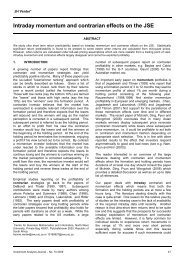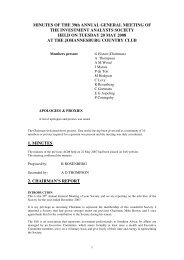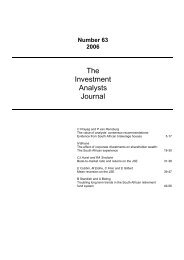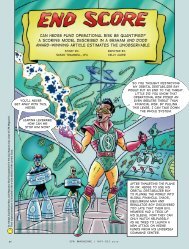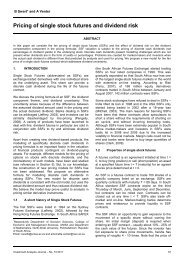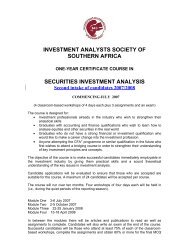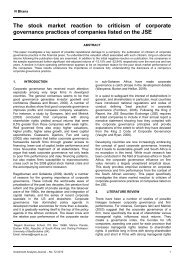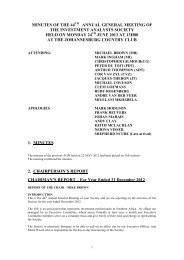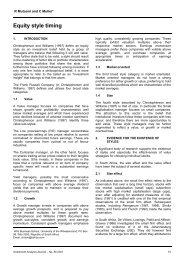Accounting is Broken - Investment Analysts Journal
Accounting is Broken - Investment Analysts Journal
Accounting is Broken - Investment Analysts Journal
Create successful ePaper yourself
Turn your PDF publications into a flip-book with our unique Google optimized e-Paper software.
Stern Stewart & Co.<br />
tends to overstate true depreciation in the early years and to understate it later on. Hence<br />
the desire by managers to defer new asset purchases and to retain old ones, and to argue that<br />
d e p reciation should be ignored when measuring earn i n g s .<br />
Straight-line book<br />
d e p reciation thus tends<br />
to overstate true depreciation<br />
in the early years<br />
and to understate it later<br />
on. Hence the desire by<br />
managers to defer new<br />
asset purchases and to<br />
retain old ones, and to<br />
a rgue that depre c i a t i o n<br />
should be ignored when<br />
measuring earn i n g s .<br />
Consider a factory asset costing $10 million that will generate $1.8 million in cash flow each<br />
year over its 10-year life. With a straight-line depreciation charge of $1 million a year, the<br />
accountants are happily left to re p o rt a steady $0.8 million in operating pro f i t 2 1 . The rate of<br />
re t u rn measured with those figures <strong>is</strong> not constant, however. In the first year it <strong>is</strong> 8%, the<br />
result of dividing the $0.8 million profit by the original $10 million investment. Looking<br />
five years later, the re t u rn seemingly soars to 16%—twice as high—because the asset has<br />
been written down half way in value, from $10 million to $5 million, but the operating pro f-<br />
it remains the same. At the outset the factory asset appears to earn less than the company’s<br />
10% cost of capital and later on a lot more. The truth lies between.<br />
E VA <strong>is</strong> subject to the same measurement d<strong>is</strong>tortion as rate of re t u rn, a fact best appre c i a t e d<br />
by adding and subtracting depreciation in a restatement of the EVA form u l a :<br />
E VA = NOPAT - (WACC% x $Total Capital)<br />
+ D e p re c i a t i o n - D e p re c i a t i o n<br />
E VA = COPAT - TCO<br />
C O PAT <strong>is</strong> cash flow<br />
f rom operations. Like<br />
EBITDA it <strong>is</strong> measure d<br />
b e f o re non-cash depreciation<br />
charges and<br />
b e f o re any deductions<br />
for investment spending<br />
or finance charg e s .<br />
TCO (“tee-koh”) <strong>is</strong> the<br />
total cost a company<br />
incurs in a period stemming<br />
from its original<br />
dec<strong>is</strong>ion to purchase and<br />
own an asset.<br />
Th<strong>is</strong> formulation depicts<br />
E VA as the earnings a<br />
company would re p o rt if<br />
it had sold and leased<br />
back all its assets.<br />
The rev<strong>is</strong>ion states that EVA may also be thought of as “cash operating profit after taxes,”<br />
or COPAT, less TCO, which <strong>is</strong> the “total cost of ownership.”<br />
C O PAT <strong>is</strong> cash flow from operations. Like EBITDA it <strong>is</strong> measured before non-cash depre c i-<br />
ation charges and before any deductions for investment spending or finance charg e s . 2 2 I t ’s<br />
superior to EBITDA as a measure of operating cash flow, however, because COPAT also<br />
deducts the taxes that must be paid on the operating profit. In the foregoing example COPAT<br />
<strong>is</strong> the $1.8 million cash flow the asset <strong>is</strong> assumed to generate each year over its 10-year life.<br />
TCO (“tee-koh”) <strong>is</strong> the total cost a company incurs in a period stemming from its original<br />
dec<strong>is</strong>ion to purchase and own an asset (excluding maintenance and repairs). It <strong>is</strong> the sum of<br />
the cost of the capital used to finance the asset and depreciation in the asset’s value. Merg i n g<br />
asset depreciation and the cost of capital <strong>is</strong> good bookkeeping because it gathers all of the<br />
c h a rges ar<strong>is</strong>ing from the balance sheet investment into one overall capital charge. Drawing<br />
the line between COPAT and TCO also makes sense because it segregates operating cash<br />
flow outcomes from investing and financing dec<strong>is</strong>ions.<br />
Taking the interpretation a step furt h e r, th<strong>is</strong> formulation depicts EVA as the earnings a company<br />
would re p o rt if it had sold and leased back all its assets. With that change the firm<br />
would no longer have a balance sheet to speak of, only an income statement. It would no<br />
longer be subject to a charge for depreciation, or the cost of capital. Its NOPAT would equal<br />
its COPAT. But the company would not avoid the cost of financing and using assets. The<br />
d e p reciation and cost of capital it has saved by selling its assets will be prec<strong>is</strong>ely offset in a<br />
competitive capital market by the rental charge it must pay for leasing them back. After all,<br />
for a leasing company to breakeven on its EVA it must charge a rent that covers its costs,<br />
which are the depreciation and the cost of capital it sustains on the assets it holds on behalf<br />
of the lessee.<br />
The question <strong>is</strong>, what rental charge <strong>is</strong> implied by TCO under current accounting rules, and<br />
does it make sense? The answer <strong>is</strong>, straight-line depreciation leads to an asset rental charg e<br />
that <strong>is</strong> front-end loaded, and that makes no sense. It <strong>is</strong> front-loaded because depre c i a t i o n<br />
<strong>is</strong> even each year but the cost of capital declines as the asset <strong>is</strong> written off .<br />
2 1<br />
For simplicity taxes are ignored and so operating profit in th<strong>is</strong> case <strong>is</strong> the equivalent of NOPAT.<br />
2 2<br />
N O PAT, like accounting profit, <strong>is</strong> measured after deducting depreciation because depreciation must be covered before investors<br />
realize a re t u rn on their investment. To emphasize that point the “net” in NOPAT stands for “net of depreciation.” Adding depreciation<br />
back to NOPAT reverses the non-cash charge and produces COPAT, the cash operating profit after tax.<br />
26




